Archive for August, 2009
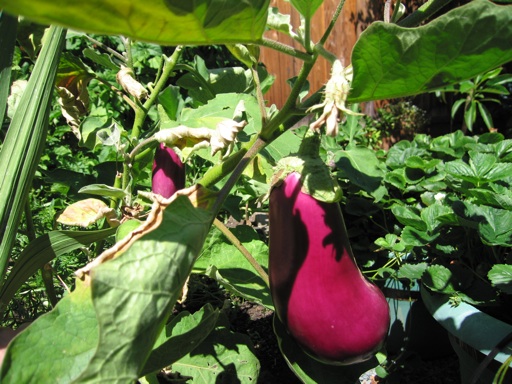
This photograph shows our neon eggplant with a large purple fruit hanging on it. We are also growing millionaire and nadia eggplants. This is the second year we have grown eggplants in our vegetable garden, and I have been pleased with the harvest both years. Our eggplants are slow growers early in the season and don’t produce fruit until later than many of our other garden vegetables. But by August, when the summer heat really kicks in, our eggplants started growing faster and producing a decent amount of fruits.
Last weekend, my partner and I made Wolfgang Puck’s vegetable gratin recipe using our home grown tomatoes, eggplants, zucchini, thyme leaves, and onions. The rest of the ingredients we used in the recipe were store bought, including the mushrooms we added to the recipe. Even with the two of us working together, it took nearly three hours to make it. It takes a long time to fry all that zucchini and eggplant.
But the end product was absolutely delicious! This vegetable gratin recipe is one of my favorites. We have made this recipe several times in the past, and we both think that this time it tasted better than ever. I attribute that flavor in part to using mostly home grown produce. The eggplants we used were so fresh, because I picked them that day, and the neon eggplants had a nice creamy white interior. I picked the zucchinis only a few days before. And all of our home grown eggplants and zucchinis had very few of the scratches, blemishes, and wrinkled spots I often see on commercial produce.
August 30 2009 | Eggplant | Comments Off on Neon Eggplant
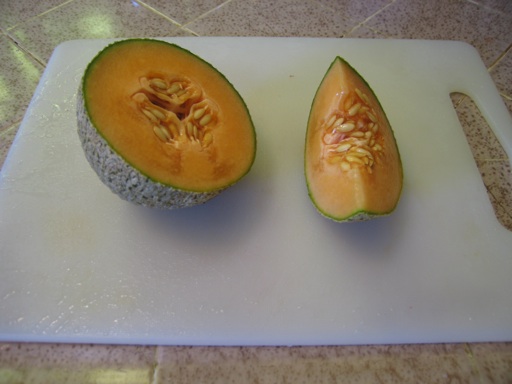
Last week, I harvested our first Hale’s Best cantaloupe fruit from the vines growing in our vegetable garden, as shown in this picture. This is the same cantaloupe shown in the photo in my July 25 post. Although I can’t say it was the best cantaloupe I have ever eaten, it was sweet and more flavorful than the typical store bought cantaloupe. However, it was small – only about 5 inches long. But I am happy just to get a small cantaloupe that’s tasty. Last year, we harvested a larger cantaloupe, but it wasn’t at all sweet.
I know that our climate is not ideal for melon growing, because the average summer high temperatures are not hot enough. So I consider this cantaloupe a partial success. I have also harvested a few more cantaloupes that are only about 3 inches long. Now I just have to figure out how to get them to set larger fruit, like grocery store cantaloupe. Perhaps, they need more fertilizer. I only gave our cantaloupe plants a few applications of water soluble fertilizer back in the spring. Perhaps, many more applications of fertilizer might work better. Maybe I will try more fertilizer next year.
August 30 2009 | Melons | Comments Off on Cantaloupe Success – Sort of
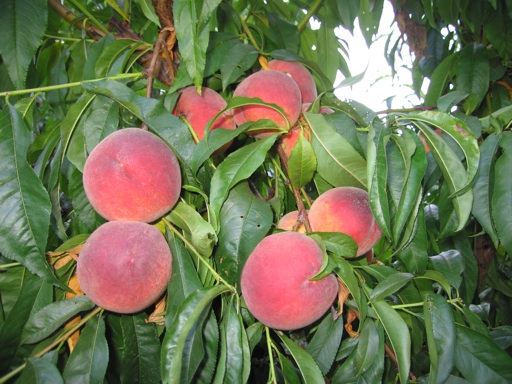
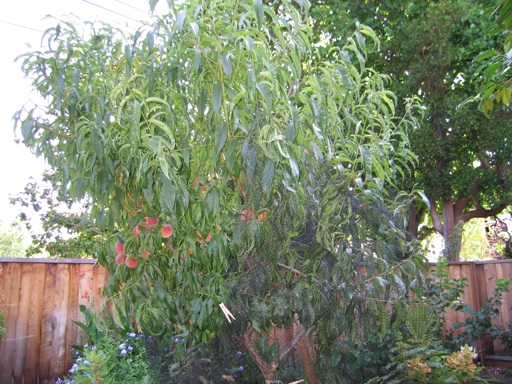
The fruit on our O’Henry peach tree is ripening. Our tree has far less fruit on it this year than last year, because I pruned it more during the dormant season. I discussed my pruning technique in an earlier post. The tree only has about 40-50 peaches this year, compared with about 200 last year, which is a more reasonable number for our needs.
This year’s crop of peaches are much larger than they were last year. They are nearly the same size as grocery store peaches. However, the ones I have tried so far taste about the same as last year’s crop. Reducing the size of crop greatly increased the size of the fruit (nearly twice as large), but it doesn’t seem to have affected the flavor much.
O’Henry is a good tasting peach, but our O’Henry’s don’t have a very sweet flavor. They have slightly more tartness than sweetness. I really want to grow peach and nectarine trees that produce exceptionally sweet fruits. So last March, I planted a white snow beauty peach tree and a white snow queen nectarine tree. Snow beauty and snow queen are supposed to produce fruits that are more sweet than tart. Here is an interesting article from Dave Wilson Nursery about white peaches and nectarines.
I sprayed our O’Henry peach tree twice early in the year for peach leaf curl. See my last post about spraying for peach leaf curl. The spray appears to have worked well. Our tree had only few leaves in the spring showing signs of leaf curl. The vast majority of the leaves were and continue to be very healthy looking and curl-free.
August 23 2009 | Peaches/Nectarines | Comments Off on O’Henry Peaches
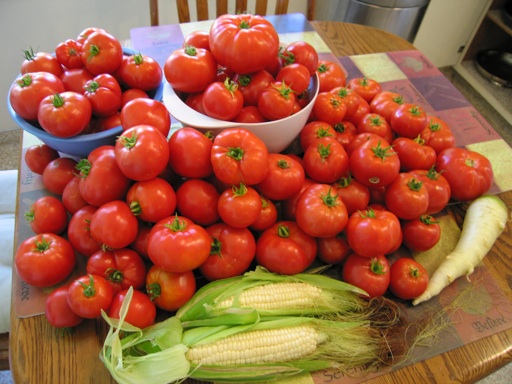
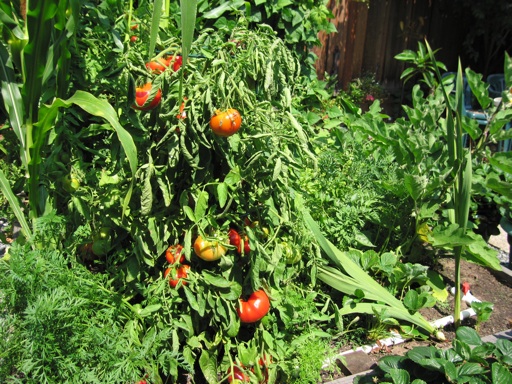
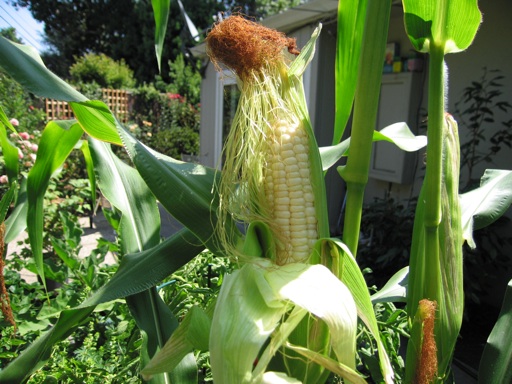
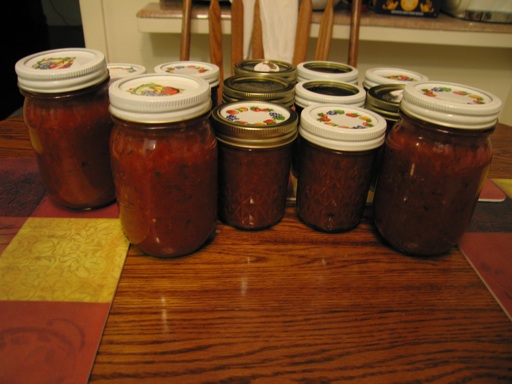
Yesterday, my partner and I harvested over 100 tomatoes from our vegetable garden. Those 100+ tomatoes came from just two plants! One was an early girl tomato and the second plant was a big beef tomato. The second picture above shows the early girl plant. It doesn’t look like it has a lot of tomatoes in this picture, which was taken before our harvest, but there were dozens of tomatoes hidden underneath the branches of this plant. And this is the second harvest of tomatoes we have gotten from our two tomato plants. We picked about 30 tomatoes from them about a month ago. We also picked carrots, onions, and 2 ears of white corn from our vegetable garden.
We spent most of the day turning our tomatoes, carrots, and onions into a basic tomato sauce, and then into pizza sauce using this recipe. The pizza sauce turned out really well. I think it is the best pizza sauce I have ever tasted. It is much more flavorful than the store bought pizza sauces we typically buy. I’m sure that’s at least partly because our home grown tomatoes are sweeter and more tender than most commercially grown tomatoes.
After spending over 6 hours cooking the sauce, we then made our own pan-fried pizza with the sauce. It was delicious. We also ate our home grown white corn, but the corn was a big disappointment. Although it was large like grocery store corn, it was also just as tasteless. Last year, we grew bi-colored yellow and white corn, which was much more flavorful. I plan on growing bi-colored corn again next year.
Pizza sauce made using this recipe is really versatile. We use it on pasta and in other Italian dishes. Because we made so much sauce, I felt that the best way to preserve the sauce for months to come was to can it.
I sterilized several jars by running them through the dishwasher. After adding the pizza sauce, I boiled the jars in a pot of boiling water for about 12 minutes to sterilize them. We filled 14 jars with pizza sauce, as you can see in the last picture above. I am not sure if these will keep for long at room temperature, because we did not add an acidifying ingredient, so I am planning on refrigerating or freezing these jars.
August 16 2009 | Corn and Tomatoes | Comments Off on From Tomatoes to Pizza Sauce
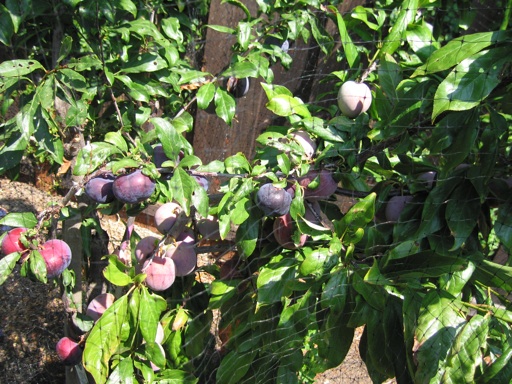
This is a photograph of our 4 variety multi-grafted plum tree taken through bird netting. I just planted this tree last February, and all 4 varieties are already full of plums. The 4 varieties are beauty, nubiana, laroda, and elephant heart. Beauty ripened in June, but its fruits were on the tart side. They really need to be picked when they are very ripe, practically ready to go bad. And even then the skin is still tart. But beauty is a good pollinator for the other three varieties.
Myself, my partner, and my sister all agree that laroda is the best tasting plum of these varieties. Although laroda needs another variety as a pollinator to bear fruit. The flesh of elephant heart has a mild sweet flavor, but the skin is tart. The elephant heart plums are the light purple plums in this picture, and the darker purple plums are nubiana. The nubiana plums are still firm and don’t seem ripe yet despite their coloring, which is strange because nubiana was supposed to ripen before elephant heart, according to the grower.
August 10 2009 | Plums | Comments Off on 4 Variety Plum Tree
Next »








